Abstract
In Chile, the hydrometallurgical plants are operating below their capacity due to a depletion of copper oxide ores. To obtain suitable pregnant leach solutions (PLSs) for hydrometallurgical plants, leaching solutions combining iodine-based oxidants and hydrogen peroxide in a chloride–acid medium, at room temperature and pressure were studied. Factorial experiments were conducted to evaluate the effects of the different leaching solution reagents (KI, NaIO3, NaCl, H2O2, and H2SO4). The results showed that the most influential variable is the H2O2 concentration; increasing the PLS concentration from 3 g/L to 15 g/L increased the copper extraction percentage by ~25%. In decreasing order of importance, the factorial experimental results showed that the H2O2, H2SO4, NaCl, NaIO3, and KI concentrations affect the copper extraction percentage. The highest copper extraction percentage (i.e., 60.6%) was obtained using a leaching solution containing the highest reagent concentrations. At these conditions, the copper concentration in the PLS was 16.9 g/L. An economic evaluation of the laboratory-scale leaching experiments showed an increase in the unit cost (USD/t Cu) for experiments involving leaching solutions without H2O2 because of poor copper concentration in the PLS. As the concentrations of the reagents NaIO3 and KI, increase, the unit cost increases, because the reagents are relatively expensive and have a limited effect on the copper extraction percentage.
1. Introduction
Copper in the earth’s crust occurs as native copper or copper-bearing minerals such as copper sulfides (e.g., chalcopyrite, chalcocite, covellite, bornite, and enargite) and copper oxides (e.g., cuprite, tenorite, chrysocolla, atacamite, and brochantite). Of these, chalcopyrite is the most abundant, accounting for 70% of all copper-bearing minerals in the earth’s crust [1]; however, most current reserves contain approximately 0.5% copper and are steadily depleting [2].
Copper oxide and copper sulfide ores are typically processed in hydrometallurgical and concentrator plants, respectively. However, because of the nature of mineral deposits and the deepening pits, copper sulfide ore extraction is increasing, whereas copper oxide ore extraction is decreasing [3,4]. According to Cochilco, Comisión Chilena del Cobre [5], the hydrometallurgical production of copper in Chile will decrease by 52% by 2030 compared to the production in 2018. Owing to the scarcity of leaching resources and no new projects in this area, it is estimated that approximately 15 Chilean hydrometallurgical plants will be closed before 2030 [6].
According to some studies [7,8,9], concentrator–refinery plants are characterized by higher operational costs and processes that require more complex equipment than those in hydrometallurgical plants. Hydrometallurgical processes are less energy-intensive, more suitable for low-grade ore, and have a lower environmental impact due to the lack of SO2 generation.
For these reasons, the heap leaching of copper sulfide ore has been extensively explored. The choice of an optimal lixiviant depends primarily on the mineralogy of the ore [10]; however, in general, the leaching of sulfide minerals is conducted in an oxidizing environment using chemical reagents such as sulfates, chlorides, ammonia, nitrates, and ozone, in combination with high temperatures and pressures. In some cases, the sulfide ore is pretreated [4,9,11,12,13,14,15]. Some sulfate-media-based technologies, in the pilot or commercial stages of implementation, are total pressure oxidation (POX; high pressure and temperature), direct EW and SX (MT-DEW-SX), and BioSigma bioleaching (involving leaching bacteria). In chloride media, technologies include the Cuprochlor process, the CESL copper process (under high pressure and temperature), and hydrocopper technology (employing agitated reactors) [6]. In order to process primary sulfide ores, all these technologies use increased temperature, or pressure in some cases, to optimize the copper extraction and overall residence time. The Chilean Copper Corporation (CODELCO) estimated that, for the next ten years, low-grade chalcopyrite would represent over 80% of copper resources [15]. The slow kinetics of chalcopyrite leaching is considered a consequence of forming a passivation layer that inhibits the dissolution of copper, causing poor copper extractions [15,16].
Conditions such as high temperature and pressure are difficult to implement and operate at a large scale in the existing facilities of traditional copper mine industries. For this reason, this study aims to develop an alternative leaching process to treat copper sulfide concentrate that yields suitable pregnant leach solutions (PLSs) for SX–EW processes, minimizing changes in the current installations.
The basis of the leaching solution is a combination of salts, such as potassium iodide (KI), sodium iodate (NaIO3) (both produced in the north of Chile), and hydrogen peroxide (H2O2) in a chloride–acid medium at room temperature.
2. Mechanisms
Hydrogen peroxide is a well-known powerful oxidant. Reaction (1) shows its decomposition reaction into water and oxygen:
Hydrogen peroxide reacts with iodide. In the literature, three mechanisms that describe the transformation of iodine species reacting with hydrogen peroxide in acidic media have been reported. The nonradical mechanisms were postulated by Liebhafsky [17,18] and Schmitz [19], and the radical mechanism was proposed by Noyes [20]. The decomposition of hydrogen peroxide using iodide may seem simple; however, the reaction occurs through a series of intermediates such as I2, I3−, and short-lived intermediates such as HIO, OH·, and OOH· [21]. The overall peroxide decomposition reaction equations involving iodide and iodate are expressed in Reactions (2) and (3), respectively:
The complete transformation of iodide to iodine is possible at sufficiently high concentrations of acid [22]; however, the concentration of iodide ions will always be governed by the equilibrium of Reaction (4):
In the absence of hydrogen peroxide, iodide also reacts in acidic media, oxidizing to produce iodine and water. See Reaction (5) [23]:
Considering the fast kinetics of the reaction of Reaction (4), Reaction (5) can also be described using Reaction (6):
On the other hand, the use of iodide in the leaching of gold-bearing materials has been extensively studied. Old technologies such as roasting and smelting pose severe environmental risks; consequently, lixiviants such as thiourea, thiosulfate, and halide (chloride, bromide, and iodide) systems have been researched.
Iodide-based gold leaching is a nontoxic cyanide-free process and involves the formation of stable gold–iodide complexes. It is understood that, under general conditions, iodine dissolves in the presence of iodide to form triiodide ions, which oxidize elemental gold to produce gold(I)–iodide complexes [24,25,26].
Over the last decade, several studies have focused on copper sulfide ore leaching, specifically, on refractory copper ores such as chalcopyrite. Studies of oxidizing agents used to enhance chalcopyrite leaching and prevent the formation of a passivation layer show that the redox potential is a very important variable in establishing a potential range in which chalcopyrite is not passivated [27]. The use of iodine as an oxidant in the leaching of copper sulfide ores was studied by Granata et al. [28]. The proposed mechanism is a two-step cyclic process in which ferric ions oxidize iodide to iodine (see Reaction (7)), which, in turn, oxidizes chalcopyrite according to Reaction (8):
Following this two-step process, the iodide is reoxidized to initiate a new cycle of reactions. The effects of ferric ion concentration, temperature, and iodide concentration on chalcopyrite leaching were investigated. It was found that after eight hours of leaching at room temperature in 0.5 g/L of iodide, the copper extraction increased from <10% to ~40% for the ore with a size fraction of 45 µm. When the temperature was increased to 50 °C, copper extraction reached 60%. Winarko et al. [29] studied the effect of different parameters on the kinetics of copper extraction in the presence of iodine. The experimental results showed that redox potential was the principal factor determining the leaching performance via controlling the iodine speciation.
Furthermore, Manabe [30] patented a leaching process conducted at room temperature and atmospheric pressure, in which the acidic leaching solution contained ferric ions, iodide, and chloride. The number of ferric ions in the leaching solution must exceed the amount of iodide by a factor of 23–120. Similarly, the amount of chloride in the leaching solution must exceed the number of ferric ions by a factor of 0.1–2.3. Maximum extraction of ~70% was achieved in a leaching solution containing 100 mg/L of iodine, 12 g/L of Fe+3, and 20 g/L of Cl−, with a pH equal to 1.5 after 20 days of leaching the copper concentrate.
Later, Sato and Manabe [31] patented a two-step leaching process for mixed sulfide copper ores at room temperature. In this process, the first stage, copper oxides and secondary sulfides copper ores are leached based on an oxidative leaching reaction using Fe+3. Then, in a second step, primary copper sulfide ores are leached by a solution containing additional iodine at low concentrations. The concentration of iodide ions to be added is 50 to 300 mg/L and preferably 50 to 100 mg/L.
Kawashiro and Miura [32] described a similar process in which the leaching solution contained 100 mg/L iodine and 5 g/L iron with a pH of 1.8. The process included a recovery step to minimize iodine loss.
In this study, ferric ions were not added to the leaching solution; however, the oxidation of iodide was achieved by adding hydrogen peroxide, according to Reactions (2) and (3). The mechanism proposed for chalcopyrite leaching is promoted by the action of several oxidants, such as triiodide, resulting from iodide/iodate oxidation, oxygen generation from peroxide decomposition, and ferric ion liberation through chalcopyrite dissolution.
Effects of PLS conditions (i.e., temperature and potential) and concentration in the following stages, such as solvent extraction and electrowinning, have been studied [33,34,35,36,37,38]. In solvent extraction, operational problems such as degradation of the extractants, diluents, crud formation, and phase trapping could be produced. In the electrowinning stage, the generation of contaminating gases, a decrease in the current density, and corrosion are the main problems in processing chloride solutions. Concerning copper solvent extraction, there is no consensus, and diverse conclusions can be found. Lu and Dreisinger [39] studied the copper extraction for four LIX extractants (LIX84-I, LIX612N-LV, XI-04003, and LIX984N); it was concluded that the copper extraction was sensitive to pH below 0.5 and was not affected by impurities except for Fe (III). Later, Lu and Dreisinger [40] proposed a novel process for copper recovery by chloride leaching and cupric solvent extraction, and a conventional sulfate electrowinning circuit. Yañez et al. [41] studied the chemical behavior of oximes (ketoxime LIX84I and modified aldoxime LIX684N-LV) both with and without chloride in the PLS. The authors found improvements in the behavior of the oximes at low pH in a chloride media, having positive effects on copper loaded in organic and in the extraction kinetics. The ketoxime extractant presented a better performance than the modified aldoxime.
Conversely, Ruiz et al. [42] reported a negative effect of chloride on the copper extraction equilibria using ketoxime (LIX 84-IC) or salicylaldoxime (LIX 860 N-IC). An improvement in extraction was found when the temperature was increased from 25 to 35 °C. Later, Ruiz et al. [43] studied the effects of chloride on extraction, using ketoxime (LIX 84-IC) and nonylaldoxime (LIX 860N-IC) extractants to elucidate the reasons for these negative effects on the extraction. The presence of chloride had a large effect on the extraction equilibria with the ketoxime and a small negative effect when the nonylaldoxime was used. This deleterious effect is attributed to an increase in the hydrogen ion activity, which decreases the equilibrium pH. Similar results were obtained using a mixed ketoxime─nonylaldoxime (LIX 984N) and an ester-modified nonylaldoxime (Acorga M5910) extractant [44]. Shakibania et al. [45] studied the chloride effect on the copper extraction also with a mixed ketoxime─nonylaldoxime (LIX 984 N) extractant. The chloride addition showed a positive impact on extraction at low pH and improvement in the kinetic. Still, it negatively affected the extraction isotherms due to a decrease in the extraction-driven forces.
One major concern on the processing solutions with high chloride concentrations (more than 30 ppm) is the corrosion by the pitting of stainless-steel cathodes. Additionally, a decrease in the number of free cupric nuclei, the decrease of the adhesive strength of the copper deposit, and the increase in the current density are the main issues in the electrowinning stage. For these reasons, washing stages were proposed to control these undesired effects [45]. For example, Zhu et al. [46] proposed two successive scrubbing stages in a synergistic solvent extraction process for chloride solutions to avoid electrolyte contamination in the electrowinning stage. In Fletcher et al. [47], the effectivity of the loaded organic washing without the loss of copper was analyzed. The results indicated that the copper presented a chloride complex that was bonded as a copper cation into the extractant reagent after the wash.
On the other hand, the requirement of iodide salts in the process is relatively low, and the effects of iodide ions at these concentrations in the solvent extraction or electrowinning stages have not been reported. There are some concerns related to possible iodine losses to the ambient affecting the operational costs of the process. Granata et al. [28] mentioned the requirement of recovery stages after the leaching stage due to the KI cost. Kuwano et al. [48] proposed a new process that includes the recovery of the iodide reagents. After the leaching stage of copper sulfide ores, the copper from the pregnant solution is recovered in a solvent extraction stage. The remaining raffinate is sent to an oxidizing process, and the produced iodine is recovered in an adsorption process with activated carbon.
In conclusion, there is no consensus on the effect of chloride in copper solvent extraction, and further studies should be done. Washing stages must be included in any design of the hydrometallurgical process considering copper chloride solutions.
3. Materials and Methods
3.1. Concentrate Characterization
Copper concentrate was used in the experiments. The samples were characterized by scanning electron microscopy (QEMSCAN, Model Zeiss EVO 50, Zeiss, Oberkochen, Germany) and X-ray diffraction (XRD) (XRD-7000 Shimadzu, Shimadzu Corporation, Kyoto, Japan). The total copper concentration was determined by atomic absorption spectrometry (AAS) (AA-6880 Shimadzu), and soluble copper was also quantified by AAS after leaching the sample in sulfuric acid at 5%.
The mineral characterization results are shown in Table 1. The total copper concentration was 29% (w/w), and the soluble copper concentration was 0.78% (w/w). The concentrate particle size corresponds to 69.4% -325# Tyler, measured with an FBRM probe (Mettler Toledo).

Table 1.
Mineral characterization of the copper concentrate.
3.2. Procedure of the Leaching Experiments
3.2.1. Effects of Hydrogen Peroxide on the Extraction of Copper during Concentrate Leaching
Leaching experiments were conducted in 1000 mL flasks. Copper concentrate (100 g) was added to the leaching solution, and the flasks were sealed with a film to avoid evaporation.
A mechanical stirrer, IKA RW 20, was used to stir the suspension at 500–600 rpm. Samples (in duplicate) were collected every 15 min for the first hour. Subsequently, samples were collected after 6, 24, 48, and 96 h of leaching. All the experiments were carried out at room temperature (18–20 °C).
Four leaching solutions were used in the experiments. The concentrations of the reagents used are listed in Table 2.

Table 2.
Leaching solution composition.
Leaching experiments were performed using leaching solutions A and B (i.e., without hydrogen peroxide). Leaching solutions C and D additionally contained 3 g/L and 15 g/L hydrogen peroxide, respectively. In all experiments, the copper concentrations in the PLS were determined as a function of time.
3.2.2. Effect of Iodide, Hydrogen Peroxide, and Chloride on the Extraction of Copper during Concentrate Leaching
Leaching experiments were designed based on the 2k factorial design. The variables analyzed and their levels are shown in Table 3. The variables included in the design matrix were pH (H2SO4 concentration) and the concentrations of iodine (KI and NaIO3), hydrogen peroxide (H2O2), and chloride (NaCl). The iodide concentrations were determined according to the relation between the iodide and copper content in the concentrate. According to the literature [30,49], the relation KI/Cuconcentrate (i.e., using mol concentration) can vary from 0.053 to 0.028. In this study, the ratio was 0.03. The leaching ratio of all experiments was 10 m3/t, according to previous leaching tests [27,50]. This leaching rate was lower than the one used in patents [30], leading to higher iodine species concentration in the leaching solutions.

Table 3.
Factors included in the experimental design and their levels.
Minitab (v.18) statistical software was used in the experimental design and the analysis of the results. In total, 32 leaching experiments were performed in duplicate. The copper concentration in the PLS was determined after 45 min of stirring, (i.e., the time needed to reach the steady state in the experiments described in Section 3.2.1). All the experiments were carried out at room temperature (18–20 °C) and atmospheric pressure.
4. Results
4.1. Effect of Hydrogen Peroxide Concentration on Copper Extraction during Concentrate Leaching
The results of the leaching experiments in the presence and absence of hydrogen peroxide are shown in Table 4 and Figure 1.

Table 4.
Experimental results for leaching performed in the presence and absence of hydrogen peroxide.
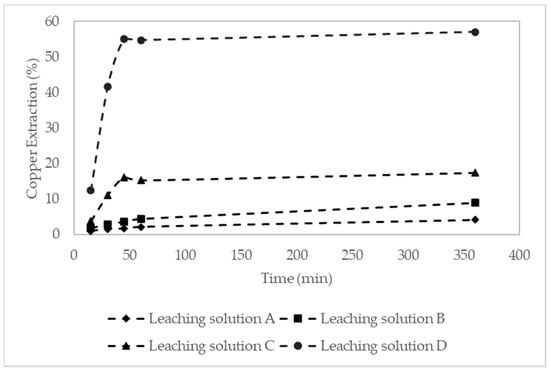
Figure 1.
Effect of hydrogen peroxide on copper extraction.
In the absence of hydrogen peroxide, low extraction percentages, less than 10% after six hours of leaching, were achieved. Adding the reagents NaCl, KI, and NaIO3 and a higher acid concentration slightly increased copper extraction from 4.2% to 9% after six hours of leaching. In experiments using leaching solutions without peroxide, the steady state was not reached after 96 h of leaching.
Adding 3 g/L of hydrogen peroxide to the leaching solution increased the copper extraction from 4.2% to 17.4% (solutions A and C, respectively). In a solution containing iodine and chlorine species and a high acid concentration, the effect of peroxide was significant, increasing the extraction from 9% (solution B) to 57.1% (solution D) after six hours of leaching.
4.2. Effects of Iodide, Hydrogen Peroxide, and Chloride on the Extraction of Copper during Concentrate Leaching
The results from the factorial experiments are shown in Table 5. These results were statistically evaluated.

Table 5.
Results for experiments based on the 2k factorial design.
4.2.1. Analysis of the Pareto Chart of Effects
The Pareto chart allows detecting the most influential factor and interaction effect in the leaching process based on the copper extraction results. It displays the absolute value of the standardized effects of different factor combinations in decreasing order. The standardized effects are t-statistics that test the null hypothesis that the effect is zero [51]. The chart also plots a reference line to indicate which effect is statistically significant. In order of importance, the most influential factors in the leaching experiments were the concentrations of hydrogen peroxide, sulfuric acid, sodium chloride, sodium iodate, and potassium iodide. Figure 2 and Figure 3 show that the hydrogen peroxide concentration is the most influential variable in the leaching process and, on average, increases the overall extraction by approximately 25%. The same order of importance was obtained when the evaluated response was the PLS copper concentration (g/L).
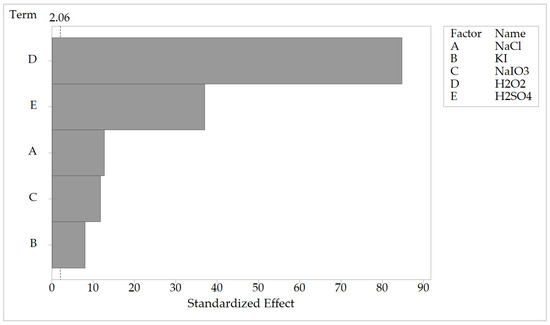
Figure 2.
Pareto chart of effects.
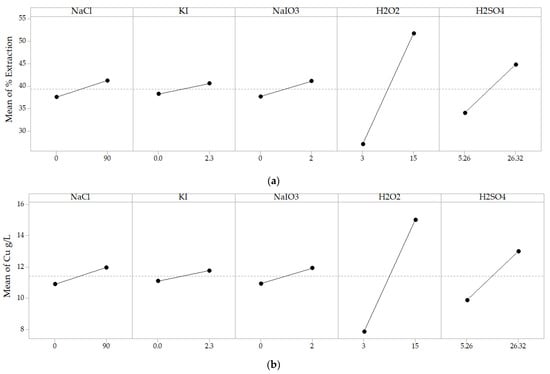
Figure 3.
Main effect plots. (a) Main effects on % Extraction as response. (b) Main effects on Cu concentration in PLS.
4.2.2. Analysis of the Main Effects
In Figure 3, the plots for the main effect exhibit the mean extraction and the mean copper concentration in the PLS, determined for each concentration (level) of the analyzed factors. A line connects each mean value. Horizontal lines represent the low effect of factors on the response (i.e., extraction or copper concentration). On the other hand, the lines that are not horizontal represent an effect on the response. The slopes of the lines represent the magnitude of the effect.
Figure 3a shows that the hydrogen peroxide concentration has the most significant effect on the leaching process, increasing the average extraction by ~25% when the concentration is increased from 3 g/L to 15 g/L. In contrast, increasing the acid concentration from 5.26 g/L to 26.32 g/L increases the copper extraction by only 10%. The effect of NaCl, KI, and NaIO3 concentration on copper extraction is negligible, with less than 5% improvement between the minimum and maximum of the reagent concentration.
The copper concentrations in the PLS strongly depend on the hydrogen peroxide content of the leaching solution (Figure 3b). The Cu concentration increases from 8 g/L to 15 g/L when the hydrogen peroxide concentration in the leaching solutions is increased from 3 g/L to 15 g/L. Increasing the acid concentration from 5.3 g/L to 26.3 g/L increases the copper concentration from 10 g/L to 13 g/L. The remaining reagents do not significantly affect the copper concentrations in the PLS.
The maximum extraction (i.e., 60.6%) and maximum copper concentration in a PLS (17.6 g/L) are achieved using the leaching solution containing the highest reagent concentrations.
4.2.3. Analysis of the Interaction Plot
The interaction plot shows the dependence between two factors on a response. In this case, the response is copper extraction.
Parallel lines indicate no interaction between the factors, while the degree of interaction increases as the difference between the slope lines increases. Figure 4 shows no interaction between the factors analyzed; therefore, there is no dependence between the factors affecting copper extraction.
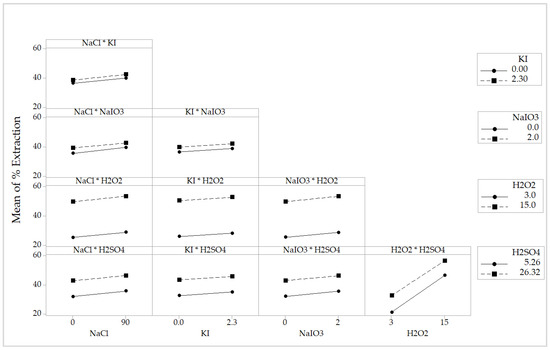
Figure 4.
Interaction plot.
4.2.4. Analysis of the Bubble Chart
Figure 5 shows the overall effect of the added reagent concentrations (H2O2, H2SO4, KI, NaIO3, and NaCl) on copper extraction during the leaching experiments. The size of the bubble represents the copper extraction percentage.
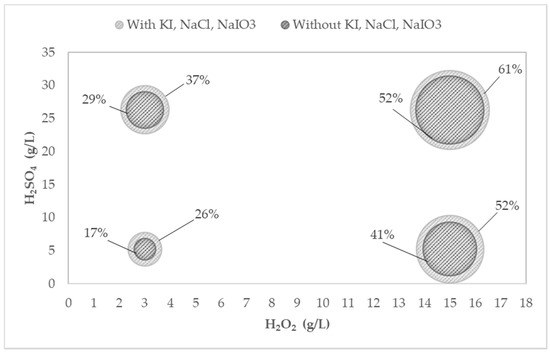
Figure 5.
Representation of the effects of reagents as a function of hydrogen peroxide and acid concentrations during copper extraction.
The dark-gray bubbles represent the extraction achieved in leaching solutions without reagents KI, NaIO3, and NaCl, as a function of the acid and hydrogen peroxide concentrations. The lowest extraction is obtained at the lower concentrations of acid (5.3 g/L) and hydrogen peroxide (3 g/L). Increasing the acid concentration in the leaching solution to 26.3 g/L increases the extraction from 17% to 29%, while increasing the hydrogen peroxide concentration to 15 g/L increases the extraction from 17% to 41%. Finally, increasing both the acid and peroxide concentrations increases the extraction to 52%.
The addition of KI, NaIO3, and NaCl to the leaching solutions (represented by light-gray bubbles) in concentrations of 2.3 g/L, 2 g/L, and 90 g/L, respectively, increases the copper extraction by ~50% at low concentrations of acid and hydrogen peroxide. As the concentration of acid and hydrogen peroxide increases, the copper extraction increases to ~25%. In the case of the leaching solution containing maximum acid and peroxide concentrations, the extraction increases to 17%. Summarizing, the leaching solution containing 90 g/L NaCl, 2 g/L NaIO3, 2.3 g/L KI, 26.3 g/L H2SO4, and 15 g/L H2O2 maximizes copper extraction (61%) after 45 min of leaching.
5. Economic Evaluation
This section presents a simplistic cost evaluation to support the discussion [52,53]. The operational costs of the leaching experiments depend on factors such as the concentration and price of the reagents used, as well the electricity and water consumption. Only the reagent consumption is considered in this evaluation because other economic factors do not vary between experiments. Table 6 shows the prices of the reagents used in the evaluation, according to the Chilean market.

Table 6.
Reagent prices used in the economic evaluation.
The unit cost per ton of the extracted copper is determined using Equation (9), where Ck is the concentration of reagent k, Vsol is the volume of the leaching solution, Pk is the reagent price, and CCu is the copper concentration in the PLS.
Table 7 lists each experiment and its associated unit cost based on the corresponding reagent consumption. Unit costs vary from 0.89 USD/t Cu to 13.06 USD/t Cu.

Table 7.
Unit costs of leaching experiments.
Four subsets can be identified and are graphically represented in Figure 6. The experiments associated with subset HC-LE are the most economically unfavorable, with high unit costs and low extraction percentages. The average unit cost is 9 USD/t Cu, and the average extraction is 27.1%. All the experiments in this section involve low hydrogen peroxide concentrations, explaining the low copper extraction percentages. The addition of NaCl, KI, and NaIO3 significantly increases the unit costs.
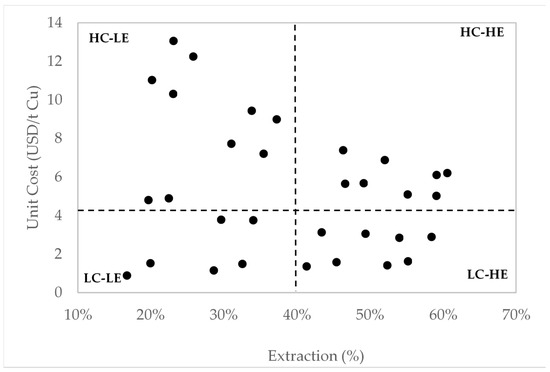
Figure 6.
Representation of different economic evaluation subsets.
On the other hand, subset LC-HE represents experiments with a low cost and high extraction. The average unit cost in this subset is 2.2 USD/t Cu, and the average extraction is 50%. These experiments include high concentrations of hydrogen peroxide. In cases with the lowest unit cost, the concentrations of KI and NaIO3 are zero. The maximum extraction percentage achieved in this subset is 58.4%, with a unit cost of 2.9 USD/t.
The experiments in subset HC-HE are characterized by high extraction percentages and high unit costs, with an average approximately three times higher than the unit cost for experiments in subset LC-HE. The experiments in subset LC-LE are characterized by low unit costs and low extraction percentages because of the absence of hydrogen peroxide in the leaching solutions.
Increasing the concentrations of KI and NaIO3 can increase the copper extraction percentages, as demonstrated in Section 4.2.2; however, the unit cost increases consequently. Figure 7 shows the evolution of the copper extraction percentage as the reagents are added. Experiment C1 uses a leaching solution containing 90 g/L NaCl, 15 g/L H2O2, and 26.3 g/L H2SO4. The leaching solution in experiment C2 contained additionally 2.3 g/L of KI, and experiment C3 contained additionally 2.3 g/L of KI and 2 g/L of NaIO3. The added KI in experiment C2 increases the extraction percentage from 55% to 58%, while the unit cost increases to 77% compared to experiment C1. The added KI and NaIO3 in experiment C3 increase the extraction from 55% to 61%. Nevertheless, the unit cost is increased by a factor of approximately four compared to experiment C1.
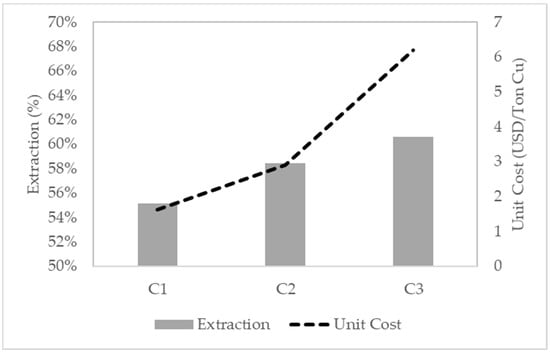
Figure 7.
Comparison of the extraction percentage and unit cost as a function of the reagents added.
On the other hand, as demonstrated in Section 4.2.1, hydrogen peroxide is the main factor determining the experimental results; high concentrations promote extraction. For this reason, the effect of hydrogen peroxide on the final unit cost is also evaluated. Four experiments were conducted and compared.
Experiments C4 and C5 used leaching solutions with an acid concentration of 5.3 g/L and no chlorine or iodine species. The leaching solution used in experiment C5 additionally contained 15 g/L of hydrogen peroxide; the experimental conditions for both experiments were the same. When hydrogen peroxide is present, the copper extraction increases from 1.7% to 41.3% (see Figure 8a). As seen in the literature review, an acidic environment is insufficient to dissolve chalcopyrite; therefore, an oxidant is used to accelerate the dissolution of copper species. Even though the unit cost is low in both cases, the unit cost in experiment C5 is 45% lower than that in experiment C4, owing to the increased copper extraction.
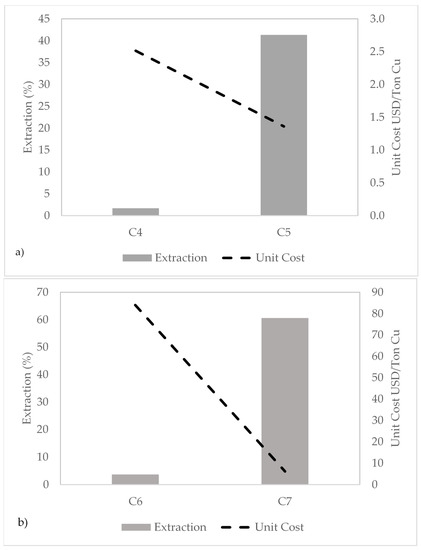
Figure 8.
Analysis of copper extraction and unit cost of experiments. (a) Leaching solution contained only sulfuric acid. (b) Leaching solution contained the highest concentration of reagents.
Figure 8b shows the results of experiments C6 and C7. Experiment C7 shows the best results concerning the extraction percentage and copper concentration in the PLS; the leaching solution contained 90 g/L NaCl, 2 g/L NaIO3, 2.3 g/L KI, 26.3 g/L H2SO4, and 15 g/L H2O2. Experiment C6 used a leaching solution with the same reagent concentrations but without H2O2.
Experiment C6 achieves a low extraction percentage (i.e., 3.7%) and copper concentration in the PLS. For this reason, the unit cost increases significantly to 84 USD/t Cu. In experiment C7, the significant copper extraction percentage (i.e., 60.6%) and associated copper concentration in the PLS reduce the unit cost to 6.2 USD/t.
6. Conclusions
This study presented an alternative leaching process, in which the base of the leaching solution was a combination of sulfuric acid and oxidant salts, such as potassium iodide (KI) and sodium iodate (NaIO3), in chloride media using hydrogen peroxide (H2O2) as a catalyst at room temperature.
In order of relevance, according to the results from the experimental design, the most significant reagents that affect the leaching results are H2O2 > H2SO4 > NaCl > NaIO3 > KI. The main effect plots demonstrated the relevance of the concentration of hydrogen peroxide; increasing this from 3 g/L to 15 g/L increased the copper extraction by ~25% on average. The addition of reagents NaCl, KI, and NaIO3, combined with a higher acid concentration, increased the extraction by less than 10% on average.
Also, the experiments showed that the slow leaching kinetics can be improved with the addition of hydrogen peroxide, reducing the required residence time, and increasing the copper extraction percentage.
The economic evaluation identified four economic subsets. The subset with the highest extraction and lower costs was characterized by experiments involving the highest concentrations of hydrogen peroxide and low concentrations of iodine species, contributing to less downstream contamination. Moreover, the economic analysis showed that an increase in the concentration of these species increases copper extraction but at a significantly higher cost. Conversely, an increase in the hydrogen peroxide concentration reduces the unit cost because of the increase in the copper extraction percentage.
Finally, it is worth mentioning that currently, in the second stage of this study, the measure of pH and potential are included in the experimental procedure to provide a deeper understanding of the leaching process.
Author Contributions
P.C.H. contributed to the experimental design and analysis of the results; N.E.J. contributed to the results review and writing; M.E.T. contributed to the review and editing; G.A.M. contributed to the experimentation and results analysis; T.A.G. contributed to the results analysis and review. All authors have read and agreed to the published version of the manuscript.
Funding
The authors are grateful for the financial support provided by the Project ING2030 CORFO Code 16ENI2-71940.
Institutional Review Board Statement
Not applicable.
Informed Consent Statement
Not applicable.
Data Availability Statement
Not applicable.
Acknowledgments
The authors would like to thank Osvaldo Herreros (QEPD) and the Doctorado en Ingeniería de Procesos de Minerales de la Universidad de Antofagasta.
Conflicts of Interest
The authors declare no conflict of interest.
References
- Li, Y.; Qian, G.; Li, J.; Gerson, A.R. Kinetics and roles of solution and surface species of chalcopyrite dissolution at 650 mV. Geochim. Cosmochim. Acta 2015, 161, 188–202. [Google Scholar] [CrossRef]
- Kartal, M.; Xia, F.; Ralph, D.; Rickard, W.D.A.; Renard, F.; Li, W. Enhancing chalcopyrite leaching by tetrachloroethylene-assisted removal of sulphur passivation and the mechanism of jarosite formation. Hydrometallurgy 2020, 191, 105192. [Google Scholar] [CrossRef]
- Watling, H.R. Chalcopyrite hydrometallurgy at atmospheric pressure: 2. Review of acidic chloride process options. Hydrometallurgy 2014, 146, 96–110. [Google Scholar] [CrossRef]
- Salinas, K.E.; Herreros, O.; Torres, C.M. Leaching of primary copper sulfide ore in chloride-ferrous media. Minerals 2018, 8, 312. [Google Scholar] [CrossRef] [Green Version]
- Cochilco. Proyección de la Producción de Cobre en Chile 2019–2030; Cochilco: Santiago, Chile, 2019. [Google Scholar]
- Cochilco. Sulfuros Primarios: Desafíos y Oportunidades; Cochilco: Santiago, Chile, 2017; DEPP 17/20; pp. 1–40. [Google Scholar]
- Watling, H.R. The bioleaching of sulphide minerals with emphasis on copper sulphides—A review. Hydrometallurgy 2006, 84, 81–108. [Google Scholar] [CrossRef]
- Dreisinger, D. Copper leaching from primary sulfides: Options for biological and chemical extraction of copper. Hydrometallurgy 2006, 83, 10–20. [Google Scholar] [CrossRef]
- Faris, N.; Ram, R.; Chen, M.; Tardio, J.; Pownceby, M.I.; Jones, L.A.; McMaster, S.; Webster, N.A.S.; Bhargava, S. The effect of thermal pre-treatment on the dissolution of chalcopyrite (CuFeS2) in sulfuric acid media. Hydrometallurgy 2017, 169, 68–78. [Google Scholar] [CrossRef]
- Ram, R.; Beiza, L.; Becker, M.; Pownceby, M.I.; Chen, M.; Yang, Y.; Yang, S.; Petersen, J. Study of the leaching and pore evolution in large particles of a sulfide ore. Hydrometallurgy 2020, 192, 1–40. [Google Scholar] [CrossRef]
- Schlesinger, M.E.; King, M.J.; Sole, K.C.; Davenport, W.G. Extractive Metallurgy of Copper; Elsevier: Amsterdam, The Netherlands, 2011; ISBN 9780080967899. [Google Scholar]
- Hernández, P.C.; Dupont, J.; Herreros, O.O.; Jimenez, Y.P.; Torres, C.M. Accelerating copper leaching from sulfide ores in acid-nitrate-chloride media using agglomeration and curing as pretreatment. Minerals 2019, 9, 250. [Google Scholar] [CrossRef] [Green Version]
- Baba, A.; Ayinla, K.; Adekola, F.; Ghosh, M.; Ayanda, O.; Bale, R.; Sheik, A.; Pradhan, S. A Review on Novel Techniques for Chalcopyrite Ore Processing. Int. J. Min. Eng. Miner. Process. 2012, 1, 1–16. [Google Scholar] [CrossRef] [Green Version]
- Watling, H.R. Chalcopyrite hydrometallurgy at atmospheric pressure: 1. Review of acidic sulfate, sulfate-chloride and sulfate-nitrate process options. Hydrometallurgy 2013, 140, 163–180. [Google Scholar] [CrossRef]
- Debernardi, G.; Carlesi, C. Chemical-electrochemical approaches to the study passivation of chalcopyrite. Miner. Process. Extr. Metall. Rev. 2013, 34, 10–41. [Google Scholar] [CrossRef]
- Dutrizac, J.E. Elemental sulphur formation during the ferric sulphate leaching of chalcopyrite. Can. Metall. Q. 1989, 28, 337–344. [Google Scholar] [CrossRef]
- Liebhafsky, H.A. The Catalytic Decomposition of Hydrogen Peroxide by the iodine iodide couple II and II. The rate of Oxidation in Neutral, and in Acid, solution of Hydrigen Peroxide by Iodine. J. Am. Chem. Soc. 1932, 54, 3499–3508. [Google Scholar] [CrossRef]
- Liebhafsky, H.A.; Mohammad, A. The Kinetics of the Reduction, in Acid Solution, of Hydrogen Peroxide by Iodide Ion. J. Am. Chem. Soc. 1933, 55, 3977–3986. [Google Scholar] [CrossRef]
- Kolar-Anić, L.; Schmitz, G. Mechanism of the Bray-Liebhafsky reaction: Effect of the oxidation of iodous acid by hydrogen peroxide. J. Chem. Soc. Faraday Trans. 1992, 88, 2343–2349. [Google Scholar] [CrossRef]
- Sharma, K.; Noyes, R. Oscillations in Chemical Systems. A Detailed Molecular Mechanism for the Bray-Liebhafsky Reaction of Iodate and Hydrogen Peroxide. J. Am. Chem. Soc. 1976, 98, 4345–4361. [Google Scholar] [CrossRef]
- Milenković, M.C.; Stanisavljev, D.R. The kinetics of iodide oxidation by hydrogen peroxide in acid solution. Russ. J. Phys. Chem. A 2011, 85, 2279–2282. [Google Scholar] [CrossRef]
- Bray, W.C.; Liebhafsky, H.A. Reactions involving hydrogen peroxide, iodine and iodate ion. I. Introduction. J. Am. Chem. Soc. 1931, 53, 38–44. [Google Scholar] [CrossRef]
- Schmitz, G. Kinetics and mechanism of the iodate-iodide reaction and other related reactions. Phys. Chem. Chem. Phys. 1999, 1, 1909–1914. [Google Scholar] [CrossRef]
- Liang, C.J.; Li, J.Y. Recovery of gold in iodine-iodide system—A review. Sep. Sci. Technol. 2019, 54, 1055–1066. [Google Scholar] [CrossRef]
- Konyratbekova, S.S.; Baikonurova, A.; Ussoltseva, G.A.; Erust, C.; Akcil, A. Thermodynamic and kinetic of iodine-iodide leaching in gold hydrometallurgy. Trans. Nonferrous Met. Soc. China 2015, 25, 3774–3783. [Google Scholar] [CrossRef]
- Baghalha, M. The leaching kinetics of an oxide gold ore with iodide/iodine solutions. Hydrometallurgy 2012, 113, 42–50. [Google Scholar] [CrossRef]
- Hernández, P.C.; Taboada, M.E.; Herreros, O.O.; Torres, C.M.; Ghorbani, Y. Chalcopyrite dissolution using seawater-based acidic media in the presence of oxidants. Hydrometallurgy 2015, 157, 325–332. [Google Scholar] [CrossRef]
- Granata, G.; Miura, A.; Liu, W.; Pagnanelli, F.; Tokoro, C. Iodide-assisted leaching of chalcopyrite in acidic ferric sulfate media. Hydrometallurgy 2019, 186, 244–251. [Google Scholar] [CrossRef]
- Winarko, R.; Dreisinger, D.B.; Miura, A.; Tokoro, C.; Liu, W. Kinetic modelling of chalcopyrite leaching assisted by iodine in ferric sulfate media. Hydrometallurgy 2020, 197, 105481. [Google Scholar] [CrossRef]
- Manabe, M. Method of Leaching Copper Sulfide Ore with the Use of Lodine. U.S. Patent 8,163,063B2, 24 April 2012. [Google Scholar]
- Sato, K.; Manabe, M. Method of Leaching Copper Ore. U.S. Patent 2013/0239752A1, 19 September 2013. [Google Scholar]
- Kawashiro, S.; Miura, A. Method of Leaching Copper from Sulfide Ore and Method of Evaluating Iodine Loss Content of Column Leaching Test of the Copper Sulfide Ore. W.O. Patent 2016/148305, 22 September 2016. [Google Scholar]
- Baral, A.; Sarangi, C.K.; Tripathy, B.C.; Bhattacharya, I.N.; Subbaiah, T. Copper electrodeposition from sulfate solutions—Effects of selenium. Hydrometallurgy 2014, 146, 8–14. [Google Scholar] [CrossRef]
- Barnard, K.R.; Kelly, N.J. Effect of long term exposure of aliphatic ELIXORE 205 diluent to acidic and oxidising conditions on copper extraction. Hydrometallurgy 2017, 169, 362–371. [Google Scholar] [CrossRef]
- Cheng, C.Y.; Hughes, C.A.; Barnard, K.R.; Larcombe, K. Manganese in copper solvent extraction and electrowinning. Hydrometallurgy 2000, 58, 135–150. [Google Scholar] [CrossRef]
- Clancy, M.; Bettles, C.J.; Stuart, A.; Birbilis, N. The influence of alloying elements on the electrochemistry of lead anodes for electrowinning of metals: A review. Hydrometallurgy 2013, 131, 144–157. [Google Scholar] [CrossRef]
- Li, G.; Wang, C.; Zhong, S.; Xie, H.; Chen, H. Identification and regeneration of degradation products from phenolic hydroxyoxime-based extractant in long-term copper solvent extraction plant. Hydrometallurgy 2019, 183, 112–117. [Google Scholar] [CrossRef]
- Liu, X.; Qiu, G.; Hu, Y. Degradation of Lix984N and its effect on interfacial emulsion. J Cent. South Univ. Technol 2006, 13, 668–672. [Google Scholar] [CrossRef]
- Lu, J.; Dreisinger, D. Solvent extraction of copper from chloride solution I: Extraction isotherms. Hydrometallurgy 2013, 137, 13–17. [Google Scholar] [CrossRef]
- Lu, J.; Dreisinger, D. Solvent extraction of copper from chloride solution II: Cuprous oxidation by oxygen coupled with simultaneous cupric solvent extraction. Hydrometallurgy 2013, 138, 48–53. [Google Scholar] [CrossRef]
- Yáñez, H.; Ardiles, L.; del Río, C. High Chloride in PLS and their Impact on Copper Solvent Extraction. In Proceedings of the Hydroprocess, Santiago, Chile, 21–23 June 2017. [Google Scholar]
- Ruiz, M.C.; Gonzalez, I.; Salgado, J.; Padilla, R. Extraction of copper from sulfate-chloride solutions by using hydroxyoxime extractants. In Applications of Process Engineering Principles in Materials Processing, Energy and Environmental Technologies; The Minerals, Metals & Materials Series; Springer: Cham, Switzerland, 2017; pp. 161–168. [Google Scholar] [CrossRef]
- Ruiz, M.C.; González, I.; Rodriguez, V.; Padilla, R. Solvent Extraction of Copper from Sulfate–Chloride Solutions Using LIX 84-IC and LIX 860-IC. Miner. Process. Extr. Metall. Rev. 2021, 42, 1–8. [Google Scholar] [CrossRef]
- Ruiz, M.C.; Risso, J.; Seguel, J.; Padilla, R. Solvent extraction of copper from sulfate-chloride solutions using mixed and modified hydroxyoxime extractants. Miner. Eng. 2020, 146, 106109. [Google Scholar] [CrossRef]
- Shakibania, S.; Mahmoudi, A.; Mokmeli, M.; Rashchi, F. The effect of chloride ions on copper solvent extraction from sulfate-chloride medium using LIX 984N. Miner. Eng. 2020, 156, 106498. [Google Scholar] [CrossRef]
- Zhu, Z.; Zhang, W.; Pranolo, Y.; Cheng, C.Y. Separation and recovery of copper, nickel, cobalt and zinc in chloride solutions by synergistic solvent extraction. Hydrometallurgy 2012, 127, 1–7. [Google Scholar] [CrossRef]
- Fletcher, A.W.; Sudderth, R.B.; Olafson, S.M. Combining sulfate electrowinning with chloride leaching. JOM 1991, 43, 57–59. [Google Scholar] [CrossRef]
- Kuwano, K.; Abe, A.; Manabe, M.; Miura, A. Method for Processing Acidic Solution that Contains Iodide Ions and Iron Ions. U.S. Patent 8,865,119B2, 21 October 2015. [Google Scholar]
- Kuwano, K.; Abe, A.; Manabe, M.; Miura, A. Method of Leaching Copper Sulfide Ore. U.S Patent 2011/0229385, 22 September 2011. [Google Scholar]
- Hernández, P.; Dorador, A.; Martínez, M.; Toro, N.; Castillo, J.; Ghorbani, Y. Use of seawater/brine and caliche’s salts as clean and environmentally friendly sources of chloride and nitrate ions for chalcopyrite concentrate leaching. Minerals 2020, 10, 477. [Google Scholar] [CrossRef]
- Minitab 18 Support Effects Plots for Analyze Factorial Design. Available online: https://support.minitab.com/en-us/minitab/18/help-and-how-to/modeling-statistics/doe/how-to/factorial/analyze-factorial-design/interpret-the-results/all-statistics-and-graphs/effects-plots/ (accessed on 15 July 2020).
- Shiers, D.W.; Collinson, D.M.; Kelly, N.J.; Watling, H.R. Copper extraction from chalcopyrite: Comparison of three non-sulfate oxidants, hypochlorous acid, sodium chlorate and potassium nitrate, with ferric sulfate. Miner. Eng. 2016, 85, 55–65. [Google Scholar] [CrossRef]
- Ntengwe, F. The Leaching of Dolomitic-Copper Ore Using Sulphuric Acid Under Controlled Conditions. Open Miner. Process. J. 2010, 3, 60–67. [Google Scholar] [CrossRef]
Publisher’s Note: MDPI stays neutral with regard to jurisdictional claims in published maps and institutional affiliations. |
© 2021 by the authors. Licensee MDPI, Basel, Switzerland. This article is an open access article distributed under the terms and conditions of the Creative Commons Attribution (CC BY) license (https://creativecommons.org/licenses/by/4.0/).